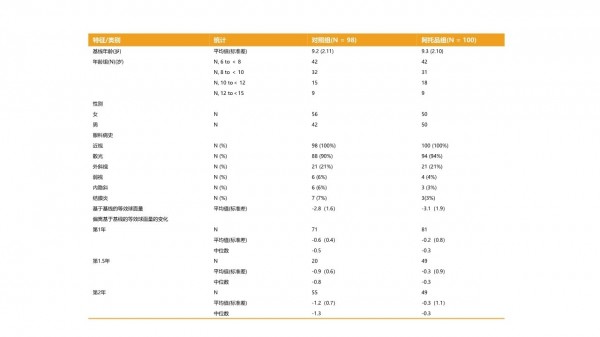Introduction Topical atropine eye drops at low concentrations have been shown to slow myopia progression in East Asian studies. This study explored the effect of atropine 0.01% eye drops on controlling myopia progression in a multiethnic cohort of children in the USA. Methods A multicenter retrospective case–control study (n = 198) quantified the effect of adding nightly atropine 0.01% eye drops to treatment as usual on the progression of childhood (ages 6–15 years) myopia. Cases included all children treated with atropine for at least 1 year. Controls were matched to cases on both age (± 6 months) and baseline spherical equivalent refraction (SER) (± 0.50 diopters, D) at treatment initiation. The primary endpoint was the average SER myopia progression after 1, 1.5, and 2 years of therapy. A secondary outcome was the percentage of subjects with a clinically significant worsening of myopia, defined as a greater than − 0.75 D SER increase in myopia. Results The average baseline SERs for the atropine (n = 100) and control (n = 98) groups were similar (− 3.1 ± 1.9 D and − 2.8 ± 1.6 D, respectively) (p = 0.23). The average SER increase from baseline was significantly less for the atropine group than the control group at year 1 (− 0.2 ± 0.8 D compared with − 0.6 ± 0.4 D, p < 0.001) and at year 2 (− 0.3 ± 1.1 D compared with − 1.2 ± 0.7 D, p < 0.001). Secondary analysis at year 2 revealed that 80% of the control group vs. 37% of the atropine group experienced clinically significant worsening myopia of at least − 0.75 D (p < 0.001). There were no major safety issues reported in either group. Conclusion Similar to results reported in Asia, atropine 0.01% eye drops significantly reduced myopia progression in a cohort of US children over 2 years of treatment. Funding Nevakar, Inc. Plain Language Summary Plain language summary available for this article.
美国眼科学会(AAO)的研究表明,大多数高加索儿童原发性近视的平均进展速度为0.5D/年。对于越来越多的高度近视儿童来说,严重且不可逆转的视力丧失风险也随着时间增加,包括视网膜脱离、视网膜下新生血管形成、早期和重度白内障以及青光眼。
近视患病率和严重程度的迅速增加正在成为一个世界性的公共卫生问题。在美国,估计有42%的人口近视,三分之一以上的儿童成年后会近视,且这个比例正在以惊人的速度增长。日前,一项0.01%阿托品滴眼液在美国三个地区的多民族样本儿童近视控制中的应用研究于Ophthalmol Ther发表。研究方法
该研究为一项多中心回顾性病例对照研究,共纳入198名6-15岁的近视儿童,且至少一只眼睛的基线等效球面量为-0.25D至-8.0D,散光≤-2.0D,眼睛治疗至少持续12个月。分为阿托品组100人和对照组98人,其中阿托品组采用0.01%阿托品滴眼液治疗,每日就寝时间给两眼各滴一次,对照组为正常治疗至少1年。医生收集基线、第1年、第1.5年、第2年的等效球面量值,评价0.01%阿托品控制近视效果。
研究结果
等效球面量/年的屈光变化被全球公认为近视进展的临床相关标志。阿托品组与对照组在基线的平均等效球面量无显著差异,且两组眼科病史大致相当。与常规护理相比,阿托品治疗的患者在治疗1年、1.5年和2年后,等效球面量的平均近视进展比基线显著降低,0.01%阿托品和常规护理在1年和2年后的平均差异分别为0.4 D和0.9 D。大多数使用阿托品的患者得到了显著的治疗效果,仅37%的患者在2年后进展超过0.75D,相比之下,对照组有80%的儿童在2年内经历了大于0.75D的进展研究结论
东亚研究表明,低浓度的阿托品滴眼液可减缓近视进展,该项研究结果与在亚洲人群中进行的研究结果一致,0.01%阿托品滴眼液在接受治疗超过2年的美国儿童中显著减缓近视进展。且该项研究中的大多数儿童来自美国的阳光地带,这表明在紫外线照射量较高的地区,近视可能仍然受益于低浓度阿托品。虽然浓度高于0.01%的阿托品也显示出减缓近视进展,但是使用更高剂量的阿托品可能受到副作用的限制,例如与视力相关的眩光、畏光和视力模糊。
综上所述,0.01%阿托品是一种耐受性良好且有效的近视干预措施,可减缓儿童近视的发展,目前美国正在进行四项大型多中心前瞻性试验来证实这些观察结果。
参考文献:
1. Larkin GL,et al. Atropine 0.01% Eye Drops forMyopia Control in American Children: A Multiethnic Sample Across Three USSites. Ophthalmol Ther. 2019 Oct 10.
来源:https://www.researchgate.net/publication/336409113_Atropine_001_Eye_Drops_for_Myopia_Control_in_American_Children_A_Multiethnic_Sample_Across_Three_US_Sites